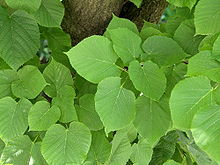- Tilia × europaea
-
Tilia × europaea Common Lime foliage Scientific classification Kingdom: Plantae (unranked): Angiosperms (unranked): Eudicots (unranked): Rosids Order: Malvales Family: Malvaceae Genus: Tilia Species: T. × europaea Binomial name Tilia × europaea
L.Synonyms - Tilia × vulgaris Hayne
Tilia × europaea L., generally known as the Common Lime, is a naturally occurring hybrid between Tilia cordata (small-leaved lime) and Tilia platyphyllos (large-leaved lime). It occurs in the wild in Europe at scattered localities wherever the two parent species are both native.[1][2]
Tilia × europaea is a large deciduous tree up to 15–50 m tall with a trunk up to 2.5 m radius. The leaves are intermediate between the parents, 6–15 cm long and 6–12 cm broad, thinly hairy below with tufts of denser hairs in the leaf vein axils. The flowers are produced in clusters of four to ten in early summer with a leafy yellow-green subtending bract; they are fragrant, and pollinated by bees. The fruit is a dry nut-like drupe 8 mm diameter, downy and faintly ribbed; .[1]
This hybrid is very widely cultivated, being readily and inexpensively propagated by layering; as a result, it is often the commonest Tilia species in urban areas and along avenues. It is not however the best species of this purpose, as it produces abundant stem sprouts, and also often hosts heavy aphid populations resulting in honeydew deposits on everything underneath the trees.[1]
References
- ^ a b c Rushforth, K. (1999). Trees of Britain and Europe. Collins ISBN 0-00-220013-9.
- ^ Flora of NW Europe: Tilia × europaea
External links
Categories:- Tilia
- Honey plants
Wikimedia Foundation. 2010.

